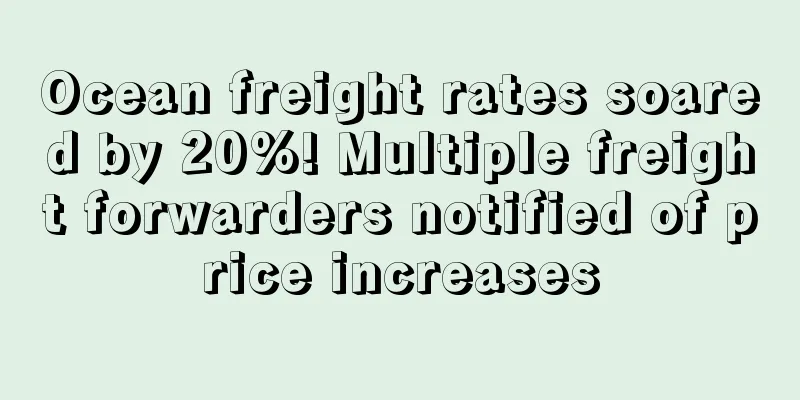Ocean freight rates soared by 20%! Multiple freight forwarders notified of price increases

|
In July, US shipping companies have reduced their sailing schedules and container abandonment has occurred frequently. With the reduction in shipping capacity, the freight rates of Matsushita and general ships have collectively risen. In the past week, many freight forwarders have issued price increase notices to sellers. However, this is not the peak of freight rates. In early August, ocean shipping will usher in another wave of price increases.
In less than a month, North American shipping prices have increased by as much as 20% twice, and freight rates have remained high since then. Currently, Prime Autumn Sale and Black Friday Online Sale have opened registration for activities, and the peak season stocking has begun. How should sellers share logistics costs?
Freight rates collectively increased by 0.5 yuan/kg, and will increase again in early August
Mr. Guo, a freight forwarder in Shenzhen , told Een.com that shipping companies have recently increased prices every two weeks. Compared with June, the prices of both Matsun and ordinary ships have increased by about 0.5 yuan/kg . At present, the prices of Matsun's limited-time sea-delivery to the US West, US Central, and US East are between 11-12-13 (yuan/kg) and 12-13-14 (yuan /kg), and the quotations of logistics companies in the industry are not much different.
Freight forwarder Jack Chen also said that the price of Meisen's last batch of goods has increased slightly, about 40 to 50 cents per kilogram, and the price of Meisen's regular sea truck has increased from more than 8 yuan to about 9 yuan.
The price increase of 0.5 yuan per kilogram may not seem big, but it is enough to cause a new round of reshuffle in the freight forwarding circle. "We are doing US lines, and the price is very competitive. Customers care a lot about the price, and 50 cents is also a threshold." Mr. Guo said.
Why do the freight rates of Matsushita and Ordinary ships rise collectively?
According to Jack Chen, in order to reduce losses, many shipping companies are currently reducing voyages or replacing large ships with small ones. In July, COSCO and EMC both shortened the sailing schedule of 1-2 North American routes, which resulted in a reduction in cargo space, an increase in freight rates and frequent container abandonment.
"We received a lot of containers in the first wave in early July, but EMC was off duty and COSCO was also a small ship, so we dropped nearly 2,000 containers. The next wave had to take on the containers dropped by the previous wave. There were container drops in every wave, so the space became even tighter."
Generally speaking, the ratio of cross-border sellers' shipments through the Matsun and general shipping channels is 2:8. However, due to the fear of being dumped, sellers tend to use the more stable Matsun in July. As the demand for Matsun increases, the price also rises.
Currently, the quotations for general ships to the US West Coast, US Central and US East Coast range from 7-8-9 (yuan /kg) to 7.5-8.5-9.5 (yuan /kg), but the logistics market has basically confirmed that freight rates will rise again soon. According to internal company information from a freight forwarder, there will be another wave of price increases in early August. "The US line is very full of space. After the price increase on the 14th, it will be pushed up again by about 400 to 600 US dollars after August 1st. If you have a plan to ship a full container, you can reserve space. "
Jack Chen confirmed the information. " We have received news that the price of the containers arriving on August 1st will increase. The increase should be around US$500 per container , which is about 40-50 cents per kilogram if spread out to the unit price . "
This year, the cross-border logistics industry has reached its peak, and the thin profits have caused many companies to be financially tight. Therefore, in the face of the indiscriminate increase in freight costs, most freight forwarding companies have raised prices in line with the market, but there are still a few companies that have not raised prices. " Maybe some companies feel that there is still a shortage of goods, so they want to grab some customers at a low price. " Jack Chen said.
" Nowadays, the US route is in the era of small profits but quick turnover. We should survive first and not think about profits. The main thing is to increase the volume of goods . If the profit is too low, customers will not do business with us. Without profit, the company will not last long . " Mr. Guo believes.
US West Coast shipping surges 20%, high freight rates continue
Judging from the overall shipping situation, due to the cancellation of flights and reduction of capacity by shipping companies, North American shipping prices have increased by as much as 20% twice in less than a month .
The weekly report on China's export container transport market released by the Shanghai Shipping Exchange shows that on the North American routes, due to the reduction in overall capacity on the US East Coast routes and the improvement in the imbalance between supply and demand, the loading factors of some shipping companies have rebounded overall, and the loading factors on the US West Coast routes have also rebounded, reaching the level of 90%~95%.
Most shipping companies raised their freight rates based on market conditions. On July 14, the freight rates (sea freight and sea freight surcharge) from Shanghai Port to the US West Coast and US East Coast base ports were US$1,771/FEU and US$2,662/FEU, up 26.1% and 12.4% from the previous period, respectively.
Half a month ago, shipping companies implemented price increase plans, which had already driven up market freight rates. On June 30, the market freight rates from Shanghai Port to the West Coast and East Coast ports of the United States were $1,408/FEU and $2,368/FEU, respectively, up 20.0% and 14.9% from the previous period.
The shipping price jumped two levels in a short period of time, and then maintained this price increase and remained at a relatively high price. On July 21, the market freight rates for Shanghai Port to the West Coast and East Coast of the United States were US$1,764/FEU and US$2,676/FEU, respectively, down 0.4% and up 0.5% from the previous period.
Stocking up for the peak season has begun, and August may see a peak in shipments
During Amazon Prime Day, sellers on the US site saw a sales explosion, and they were more confident about stocking up for the peak season. Currently, the Prime Autumn Promotion and the Black Friday Cyber Monday seven-day promotion have both opened for registration, and many sellers have already submitted their applications. The next step is to prepare for stocking up intensively.
One seller said: "There are less than three months left until the fall Prime Day. I started shipping two months' worth of goods two weeks ago. There are many festivals at the end of the year, so I still have to prepare the goods in advance."
However, Jack Chen learned from many logistics colleagues that the current market shipment volume is not too large, probably because there is still some time before the peak season to prepare stocks . They expect a small peak in shipments in August. From the current situation, the freight rate may only have room to rise, and sellers can send ordinary ships to share the cost.
Most sellers will consider cost saving and mainly ship by ordinary ships, and only ship by Matsushita Shipyard when they need to replenish stocks urgently. Previously, ordinary ships had fixed voyages and rarely dropped containers, so sellers would use ordinary ships more often for shipments. However, the frequent dropped containers in July caused sellers to worry, and the shipment volume began to shift to Matsushita Shipyard. In terms of timeliness, ordinary ships are 7-10 days slower than Matsushita Shipyard under normal circumstances, but if dropped containers occur, it may take 1-2 weeks longer.
Next, perhaps it is not just the US route that will see price increases. Recently, Maersk, CMA CGM, MSC, Hapag-Lloyd and many other shipping companies have successively raised FAK rates on some routes. Most of these fee adjustments will take effect at the end of July or early August, when prices in the global shipping market may rise to a certain extent.
Some industry organizations have analyzed that after the increase in shipping costs, freight forwarding companies, which have been in a cold winter this year, will have an easier time: first, the large freight base can appropriately increase profits; second, the fluctuation of shipping costs means that customers will re-select freight forwarders, and there will be opportunities to find new customers.
But for cross-border sellers, costs will inevitably rise. In the disclosed 2023 semi-annual performance forecast, the industry's major sellers analyzed the reasons for the increase in profits, one of which is the sharp drop in shipping costs. However, this positive factor will be weakened in the second half of this year. |
Recommend
CMA CGM: Ocean freight will be based on the actual sailing date
Recently, shipping giant CMA CGM announced that i...
Meikeduo won the second quarter! Net income was US$2.6 billion and 275.2 million items were sold
Recently, Latin American e-commerce giant Mercado...
Will Amazon ban you from selling without insurance? Here’s the solution
At the beginning of the new year, before the sell...
Is the distribution model still the first choice for many small sellers to enter the market?
Which model should I choose: general distribution...
Another large-scale problem breaks out! Amazon sellers are confused
Amazon sellers are confused due to the low order ...
What is empisports? empisports Review, Features
empisports is an exciting, contemporary brand focu...
What is teastudio278? teastudio278 Review, Features
teastudio278 is an online store dedicated to selli...
What is flosmall? flosmall Review, Features
flosmall is the official e-commerce online agent o...
Amazon Europe has new rules for clothing; eBay releases seller protection measures
Amazon Europe will update the requirements for cl...
The company went bankrupt and used the store to pay wages, but the operation took over and turned a profit
Some companies simply announced their dissolution...
What is FINTRAC? FINTRAC Review, Features
<span data-docs-delta="[[20,{"gallery"...
65% of Americans intend to buy DTC brand products, down from last year
According to the 2022 Direct-to-Consumer Purchase...
Beauty and apparel categories set to rebound as North American consumer behavior becomes permanent
Beauty and apparel sales to rebound According to ...
Amazon announces partnership with U.S. Congress to support small businesses
Although it may face blows from antitrust bills i...
What is Xuzhou Logistics? Xuzhou Logistics Review, Features
Xuzhou Logistics is a modern logistics company in...









